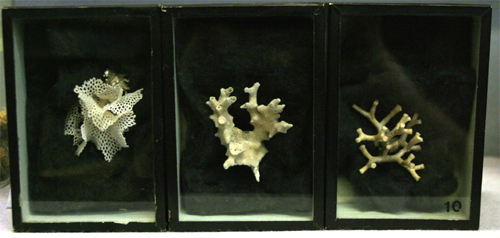
PHYLUM BRYOZOA | |
Although minute in size the Bryozoa is a very successful group - there are 4000 living species and 15000 recorded fossil species. Ashworth was not the only Professor of Natural History to be interested in these tiny animals. In 1856, George Allman (1855-1870) published a monograph on the freshwater bryozoa, which he illustrated with his own detailed and exquisite paintings. His introduction summarises the main features of the phylum. ‘They are chiefly inhabitants of the sea, where they may be witnessed under numerous plant-like guises; now spreading like a lichen over submerged stones or sea-weeds; now forming soft, irregular fungus-like masses or hard, calcareous branchy growths; and now again presenting the appearance of moss, offering even to the unassisted eye, in the endless repetition of the same element of form, objects of surpassing symmetry and beauty. The Bryozoa, however, are not by any means exclusively confined to the ocean; and though by far the greater number are marine, yet in the still and running waters of the land – in the broad river and rushing stream – in the pure, cold mountain lake and the stagnant waters of the moory fen, species are to be found which in interest yield not one jot to their brethen of the sea and offer to the naturalist an inexhaustible source of gratification in the beauty of their forms and the wonders of their organisation.’ Dried specimens of Retepora cellulosa, Cellepora sp. and Myriozoum truncatum from Naples illustrate the overall architecture of marine bryozoa.
|
 |
| FRESH WATER BRYOZOA | MARINE BRYOZOA |






